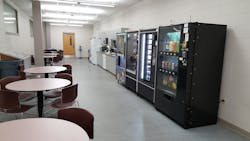Does The Successful Future Of Work Hinge On The Breakroom?
I’ve been wondering for a while now how, and indeed if, the new workplace lounge concept replacing breakrooms and even cubicles in tech companies and competitive industries would become mainstream. After all, not including Fortune’s 100 Best Companies To Work For, there are thousands of businesses who have a long-established view of the workplace. These companies aren’t adding ping pong tables or office coffee espresso brewers, but instead the notion that a workplace should reflect…well, work. The location itself should be structured, with set hours for disciplined employees who work in stations crafted from unobtrusive colors while listening to muzak – the whole scene lit with energy saving fluorescents. In the breakroom, vending machines are the highlight, providing color and vibrancy among hard, practical chairs and unadorned tables. It always reminds me of a line I heard on That 70’s Show, which went something like “Work is work. If it wasn’t work, they would call it something different, like super happy fun time.” So with a majority of businesses that still have this legacy view of the office, will it ever really change?
YES, because it drives innovation
According to Seth Mattison, the corporate view of work (and work environments) is already changing, and gaining quickly. He has been studying workforce trends and generational dynamics for over ten years, and has insights on how each generation’s story shapes their views of the world. He believes the workplace of the future will look quite different, even beyond the progressive minority. One reason is the Millennials. The newest entrants to the workforce grew up in a culture of coffee shops and cafes. This is where they completed assignments, collaborated on projects and socialized, using the latest technology and software. This is how they work.
Another factor contributing to the evolution of corporate breakrooms is the increase in research about how the isolating cubicle farms and telecommuting of the past (and current) do not produce the new ideas that companies need to stay nimble and successful in today’s market.
“Many employers are carrying around an old story about what work is going to look like,” Mattison told me. “They haven’t been armed with the strategic implications of what a physical space can do to facilitate collaboration and innovation.”
Breakrooms need to be places that invite people to network with each other, about work, which sparks fresh solutions. “We have left behind the days where the breakroom acted as a place to ‘break’ from work,” said Mattison. Instead, he observes that the physical ‘breakroom’ space will inspire, facilitate and engage employees, which will bring them back to the company location, and also to the breakroom itself. The right corporate lounge, and a company could be looking at productivity gains that aren’t related to the numbers of hours worked, but the quality of work, all because of the physical space we call the breakroom.
It also means OCS providers might have to move out of their comfort zones. Mattison pointed out that operators will not effectively be able to sell their clients on new, collaborative lounges if they don’t believe the concept and practice it in their own businesses. Operators will have to connect with architects, designers and workplace experts to have a competitive advantage in selling these breakrooms of the future to clients, as well.
Where to learn more: CTW
Mattison will be presenting the keynote session at the 2016 Coffee Tea and Water Show in Nashville, TN, and I’m excited to hear him speak again. His view of a more open, inspiring workplace that has premium drinks and snacks appeals to me as an employee, but also as a member of the industry. This is great news, as it promises an increase in consumers in offices, in necessary services and in premium products.
There’s no doubt that all this breakroom change starts with larger companies (500 million or more in annual revenues, according to Mattison), but as awareness of the positive effects a corporate lounge has on innovation and productivity grows, more and more companies will embrace the concept. Personally, I will be glad to see the breakroom (and those who service it) be brought out into the spotlight for the contributions made to a company’s bottom-line. Its attention well deserved.
About the Author

Emily Refermat
Emily Refermat began covering the vending industry in 2006 and served as editor of Automatic Merchandiser from 2012 to 2019. To reach the current editor of Automatic Merchandiser and VendingMarketWatch.com, email [email protected].
